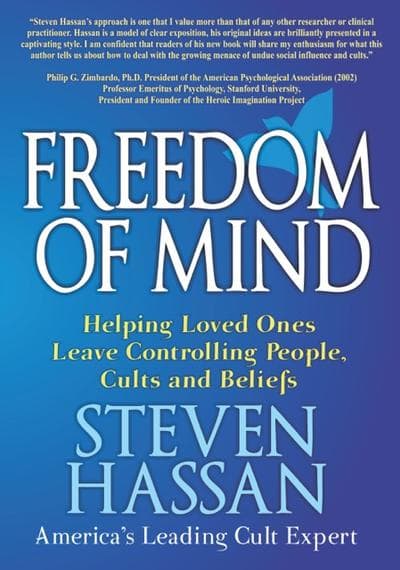Advertisement
Former Moonie Discusses Cults, Post Sun Myung Moon
Resume
When Rev. Sun Myung Moon died recently, he left behind a business empire — dealing in things like construction, media, even distributing raw fish for sushi.
But he also headed up a religious cult — he claimed to be the reincarnation of Jesus Christ.
And for decades, young people in countries around the world joined Moon's Unification Church.
What happens now that he's dead? Our guest, Steven Hassan, was a Moonie, but he got out and became an expert on how cults indoctrinate members.
Books by Steven Hassan:
Book Excerpt: 'Freedom Of Mind'
By: Steve Hassan
Steven Alan Hassan's BITE Model of Cult Mind Control
 Many people think of mind control as an ambiguous, mystical process that cannot be defined in concrete terms. In reality, mind control refers to a specific set of methods and techniques, such as hypnosis or thought- stopping, which influence how a person thinks, feels, and acts. Like many bodies of knowledge, it is not inherently good or evil. If mind control techniques are used to empower an individual to have more choice, and authority for his life remains within himself, the effects can be beneficial. For example, benevolent mind control can be used to help people quit smoking without affecting any other behavior. Mind control becomes destructive when the locus of control is external and it is used to undermine a person’s ability to think and act independently.
Many people think of mind control as an ambiguous, mystical process that cannot be defined in concrete terms. In reality, mind control refers to a specific set of methods and techniques, such as hypnosis or thought- stopping, which influence how a person thinks, feels, and acts. Like many bodies of knowledge, it is not inherently good or evil. If mind control techniques are used to empower an individual to have more choice, and authority for his life remains within himself, the effects can be beneficial. For example, benevolent mind control can be used to help people quit smoking without affecting any other behavior. Mind control becomes destructive when the locus of control is external and it is used to undermine a person’s ability to think and act independently.As employed by the most destructive cults, mind control seeks nothing less than to disrupt an individual’s authentic identity and reconstruct it in the image of the cult leader. I developed the BITE model to help people determine whether or not a group is practicing destructive mind control. The BITE model helps people understand how cults suppress individual member's uniqueness and creativity. BITE stands for the cult's control of an individual's Behavior, Intellect, Thoughts, and Emotions.
It is important to understand that destructive mind control can be determined when the overall effect of these four components promotes dependency and obedience to some leader or cause. It is not necessary for every single item on the list to be present. Mind-controlled cult members can live in their own apartments, have nine-to-five jobs, be married with children, and still be unable to think for themselves and act independently.
The BITE Model
I. Behavior Control
1. Regulation of individual’s physical reality
a. Where, how, and with whom the member lives and associates
b. What clothes, colors, hairstyle the person wears
c. What food the person eats, drinks, adopts, and rejects
d. How much sleep the person is able to have
e. Financial dependence/ financial manipulation
f. Little or no time spent on leisure, entertainment, vacations
2. Major time commitment required for indoctrination sessions and group rituals
3. Need to ask permission for major decisions
4. Need to report thoughts, feelings, and activities to superiors
5. Rewards and punishments (behavior modification techniques—positive and negative)
6. Individualism discouraged; “group think” prevails
6. Rigid rules and regulations
II. Information Control
1. Use of deception
a. Deliberately holding back information
b. Distorting information to make it more “acceptable”
c. Outright lying
2. Access to non-cult sources of information minimized or discouraged
a. Books, articles, newspapers, magazines, TV, radio
b. Critical information
c. Former members
d. Keep members so busy they don’t have time to think and check things out
3. Compartmentalization of information; Outsider vs. Insider doctrines
a. Information is not freely accessible
b. Information varies at different levels and missions within pyramid.
4. Spying on other members is encouraged
a. Pairing up with “buddy” system to monitor and control
b. Reporting deviant thoughts, feelings, and actions to leadership
c. Individual behavior monitored by whole group.
d. Leadership decides who “needs to know” what and when
5. Extensive use of cult generated information and propaganda
a. Newsletters, magazines, journals, audiotapes, videotapes, and other media
b. Misquotations, statements taken out of context from non-cult sources
6. Unethical use of confession
a. Information about “sins” used to abolish identity boundaries
b. Past “sins” used to manipulate and control; no forgiveness or absolution
7. Need for obedience and dependency
III. Thought Control
1. Need to internalize the group’s doctrine as “Truth”
a. Adopting the group’s map of reality as “Reality” (Map = Reality)
b. Black-and-White thinking
c. Good vs. Evil
d. Us vs. Them (inside vs. outside)
2. Use of “loaded” language (for example, “thought-terminating clichés”). Words are the tools we use to think with. These “special” words constrict rather than expand understanding and can even stop thoughts altogether. They function to reduce complexities of experience into trite, platitudinous “buzz words.”
3. Only “good” and “proper” thoughts are encouraged.
4. Use of hypnotic techniques to induce altered mental states
5. Manipulation of memories and implantation of false memories
6. Use of thought-stopping techniques, which shut down “reality testing” by stopping “negative” thoughts and allowing only “good” thoughts
a. Denial, rationalization, justification, wishful thinking
b. Chanting
c. Meditating
d. Praying
e. Speaking in “tongues”
f. Singing or humming
7. Rejection of rational analysis, critical thinking, constructive criticism. No critical questions about leader, doctrine, or policy seen as legitimate
8. No alternative belief systems viewed as legitimate, good, or useful
IV. Emotional Control
1. Manipulate and narrow the range of a person’s feelings
2. Make the person feel that if there are ever any problems, it is always his fault, never the leader’s or the group
3. Feelings Stopping (like thought stopping- but blocking affect states)
4. Excessive use of guilt
a. Identity guilt
1. Who you are (not living up to your potential)
2. Your family
3. Your past
4. Your affiliations
5. Your thoughts, feelings, actions
b. Social guilt
c. Historical guilt
5. Excessive use of fear
a. Fear of thinking independently
b. Fear of the “outside” world
c. Fear of enemies
d. Fear of losing one’s “salvation”
e. Fear of leaving the group or being shunned by group
f. Fear of disapproval
6. Extremes of emotional highs and lows
7. Ritual and often public confession of “sins” (used, never forgotten)
8. Phobia indoctrination: inculcating irrational fears about ever leaving the group or even questioning the leader’s authority. The person under mind control cannot visualize a positive, fulfilled future without being in the group.
a. No happiness or fulfillment outside of the group
b. Terrible consequences will take place if you leave: hell, demon possession, incurable diseases, accidents, suicide, insanity, 10,000 reincarnations, etc.
c. Shunning of leave takers; fear of being rejected by friends, peers, and family
d. Never a legitimate reason to leave. From the group’s perspective, people who leave are “weak,” “undisciplined,” “unspiritual,” “worldly,” “brainwashed by family or counselor,” or “seduced by money, sex, rock and roll.”
Excerpted from "Freedom of Mind: Helping Loved Ones Leave Controlling People, Cults and Beliefs" by Steven Hassan.
- Daily Beast: Twilight Of The Moonies And Scientologists?
Guest:
This segment aired on September 19, 2012.